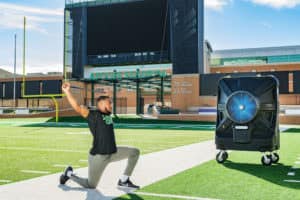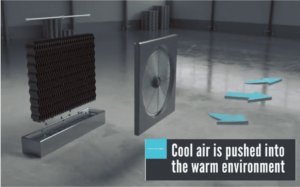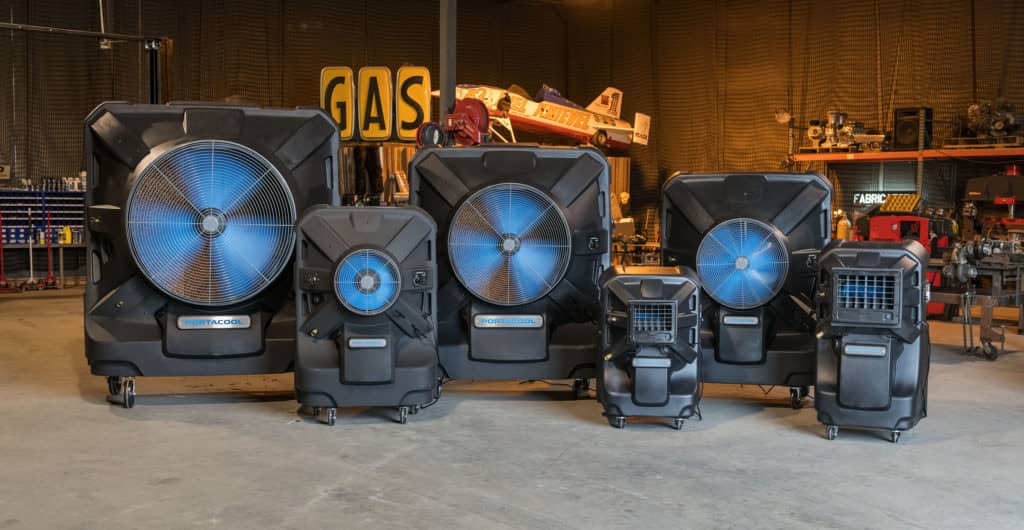
Today, many people are familiar with traditional cooling methods ranging from air conditioning to fans to prevent heat stress, increase productivity, and provide an overall more comfortable environment whether at work or play. Air conditioning works in closed spaces where the recirculated cool air can be maximized with the use of refrigerants and a compressor. Fans – both oscillating and ceiling options – generate air but it is not chilled in any capacity.
What about evaporative cooling? What is it exactly? Evaporative cooling is, quite simply, cooling with water and it has been used since ancient Egyptian times. A few relatable examples of evaporative cooling at work is the cooling sensation felt when climbing out of a swimming pool, perspiration as a form of natural cooling to the body, or feeling the cool breeze blowing across a lake. In years past, evaporative coolers were also known as swamp coolers, but as they have been come more efficient and better at providing cooling in both dry and humid climates, the terminology has changed. By evaporating water, the temperature of the air in contact with the liquid water will lower as an endothermic reaction takes place. During this reaction, the liquid water changes to a gas, and the temperature of the air lowers.
Assuming standard atmospheric pressure, water will evaporate at any temperature between 32°F (0°C) and 212°F (100°C). At 32°F the water is frozen – or in solid-state. Above 212°F the water is boiling and is eventually going to turn to steam – its gas state. Water in both solid and gas forms cannot provide any evaporative cooling effect. In the space between solid and gas forms though, the amount of cooling you can expect from evaporative cooling has to do with how much distance is between the wet bulb and dry bulb temperatures.
We’ll break it down for you. If the humidity level (wet bulb temperature) is below 100% there is room for SOME evaporation. The higher the air temperature (dry-bulb temperature) is, the faster evaporation can happen, and the cooler the air will be. The more space between your wet bulb and dry bulb temperatures, the higher your evaporation efficiency will be.
In the real world, as temperatures rise, humidity levels go down. For the most part, when the air temperature (dry bulb) goes up, humidity (wet bulb) will go down. Of course, rain is an exception to the rule. Honestly, most of us are not good at judging how hot it is or what the humidity level is without equipment. Under natural conditions, it cannot be 100°F with 90% humidity even if it might feel that way to us.
A portable evaporative cooler essentially works off this principle by acting as a cooling fan that uses water, a pump, and a wetted surface to create the naturally occurring process of evaporation to cool warm air and drop temperatures. By pulling air across the water, the temperature of the air will be lowered.

One unique aspect of the evaporative cooler is that it actually works best with a supply of outside ambient air — or even in an outside setting — to deliver a temperature reduction and cooling effects. While evaporative coolers achieve significant temperature drops in more arid climates and drier spaces, they provide relief from the heat in any environment, even humid climates. For example, in regions where relative humidity reaches 70% at midday with temperatures higher than 90 degrees Fahrenheit, evaporative coolers have been shown to offer noteworthy relief. Given that relative humidity is lowest in the afternoon when the temperature is at its highest, an effective evaporative cooling scenario is achievable. In addition, evaporative cooling is extremely energy efficient, often using as little as $1 a day.
The technology at the center of an evaporative cooling system is the evaporative media that allows water to interact with the air. In this scenario, air passes through the media and is cooled as the water evaporates. The evaporative media is specially treated to prevent deterioration and ensure long service life. A special water distribution system spreads water over the surface of the media within the cooling unit to ensure uniform water supply. This keeps the entire air to contact the surface thoroughly wet. A control system operates the water pump and distributes the cool air.
The first part of making any item stand out from the competition is the engineering that goes into the product. At Portacool, we have a whole team of engineers dedicated to making our Kuul evaporative media as efficient as possible. We consistently have the lowest pressure drops, highest evaporative efficiency, and the longest-lasting durability of any evaporative media on the market. Second, our products are only made with the highest quality and purest raw materials available. We pride ourselves on the high quality of our finished goods. We put everything we have into the products we make, and we want you to love using them as well as working with us.

Our Portacool evaporative coolers all come equipped with Kuul Comfort™ evaporative media. We are the only evaporative cooler manufacturer that makes its own evaporative media. Meaning we can design it to our exact desired performance specifications.
Check out our awesome evaporative cooling video!
You can also request more information or a site visit from our sales team on our website.
Schedule a Demo